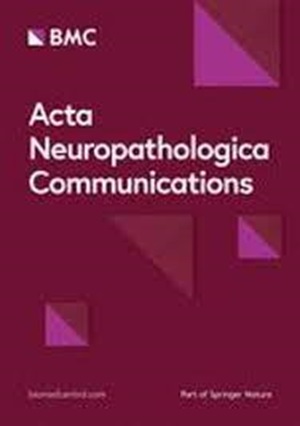脊索瘤的基因组特征和临床表现
IF 6.2
2区 医学
Q1 NEUROSCIENCES
引用次数: 0
摘要
脊索瘤是一种罕见的骨癌,临床疗效不一。在此,我们从美国和加拿大招募了 184 名散发性脊索瘤患者,并收集了他们的临床和治疗数据。患者确诊时的平均年龄为 45.5 岁(5-78 岁不等),脊索瘤的部位分布为髂骨占 49.2%,脊柱占 26.2%,骶骨占 24.0%。大多数患者(97.5%)接受了手术作为主要治疗方法,其中 85.3% 的患者还接受了其他治疗方法。除了前列腺癌、肺癌、乳腺癌和皮肤癌等最常见的癌症外,患者或其家庭成员中没有明显的特定癌症类型富集现象。在有肿瘤材料的患者子集(N = 70)中,我们进行了omics分析,并分别获得了51名和49名患者的靶向面板测序和SNP阵列基因分型数据。最常见的体细胞驱动突变包括PIK3CA(12%),其次是染色质重塑基因PBRM1和SETD2。8名患者(16.3%)检测到包含脊索瘤易感基因TBXT的6q27区域扩增。与骶骨患者相比,椎体患者携带驱动基因突变、染色体臂水平缺失事件(如5p、5p和9p)或6q27扩增的可能性较小。在对年龄、性别、肿瘤部位和额外治疗进行调整后,14q(OR = 13.73,95% CI 1.96-96.02,P = 0.008)和18p(OR = 13.68,95% CI 1.77-105.89,P = 0.012)体细胞缺失的患者更有可能患持续性脊索瘤。该研究强调了脊索瘤的基因组异质性,这可能与位置和临床进展有关。本文章由计算机程序翻译,如有差异,请以英文原文为准。
Genomic profiles and clinical presentation of chordoma
Chordoma is a rare bone cancer with variable clinical outcomes. Here, we recruited 184 sporadic chordoma patients from the US and Canada and collected their clinical and treatment data. The average age at diagnosis was 45.5 years (Range 5–78) and the chordoma site distribution was 49.2% clivus, 26.2% spinal, and 24.0% sacral. Most patients (97.5%) received surgery as the primary treatment, among whom 85.3% also received additional treatment. Except for the most prevalent cancers like prostate, lung, breast, and skin cancer, there was no discernible enrichment for any specific cancer type among patients or their family members. Among a subset of patients (N = 70) with tumor materials, we conducted omics analyses and obtained targeted panel sequencing and SNP array genotyping data for 51 and 49 patients, respectively. The most recurrent somatic driver mutations included PIK3CA (12%), followed by chromatin remodeling genes PBRM1 and SETD2. Amplification of the 6q27 region, containing the chordoma susceptibility gene TBXT, was detected in eight patients (16.3%). Clival patients appeared to be less likely to carry driver gene mutations, chromosome arm level deletion events (e.g., 5p, 5p, and 9p), or 6q27 amplification compared to sacral patients. After adjusting for age, sex, tumor site, and additional treatment, patients with somatic deletions of 14q (OR = 13.73, 95% CI 1.96–96.02, P = 0.008) and 18p (OR = 13.68, 95% CI 1.77–105.89, P = 0.012) were more likely to have persistent chordoma. The study highlights genomic heterogeneity in chordoma, potentially linked to location and clinical progression.
求助全文
通过发布文献求助,成功后即可免费获取论文全文。
去求助
来源期刊

Acta Neuropathologica Communications
Medicine-Pathology and Forensic Medicine
CiteScore
11.20
自引率
2.80%
发文量
162
审稿时长
8 weeks
期刊介绍:
"Acta Neuropathologica Communications (ANC)" is a peer-reviewed journal that specializes in the rapid publication of research articles focused on the mechanisms underlying neurological diseases. The journal emphasizes the use of molecular, cellular, and morphological techniques applied to experimental or human tissues to investigate the pathogenesis of neurological disorders.
ANC is committed to a fast-track publication process, aiming to publish accepted manuscripts within two months of submission. This expedited timeline is designed to ensure that the latest findings in neuroscience and pathology are disseminated quickly to the scientific community, fostering rapid advancements in the field of neurology and neuroscience. The journal's focus on cutting-edge research and its swift publication schedule make it a valuable resource for researchers, clinicians, and other professionals interested in the study and treatment of neurological conditions.
 求助内容:
求助内容: 应助结果提醒方式:
应助结果提醒方式:


